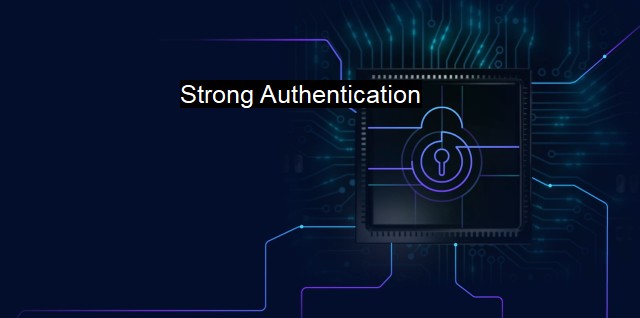What is Strong Authentication?
Beyond Passwords: The Critical Importance of Strong Authentication in Today's Cybersecurity Landscape
Strong authentication, also known as multi-factor authentication or two-factor authentication, is a security process in which a user must provide two or more verification factors to gain access to a resource such as a system, network, or database. This concept has become an integral component of the broader field of cybersecurity, and serves as a focal point for numerous antivirus software strategies.To gain a fuller understanding of strong authentication, one must first apprise oneself of the conventional alternative: single-factor authentication (SFA). With SFA, users typically only need to provide a username and password to access a resource. Regrettably, this method is increasingly vulnerable to cyber attacks. Malicious actors can procure usernames and passwords through techniques such as phishing or brute force attacks, often resulting in unauthorized access, data breaches, and severe financial losses.
Strong authentication mitigates these risks by requiring additional verification factors that are considerably harder for cyber criminals to procure. Generally, these factors follow three categories: something you know, something you have, and something you are.
'Something you know' refers to information unique to the user, often a password or PIN (Personal Identification Number). 'Something you have' denotes a physical device in the user's possession, such as a hardware wallet or a mobile phone to which an authentication code can be sent. 'something you are' refers to biometric elements, such as a fingerprint, facial pattern, or iris pattern. This tier of authentication is becoming more common, bolstered by advancements in biometric technologies and smartphone adaptability.
When employed properly, strong authentication provides rigorous cybersecurity defences, making it significantly harder for cyber criminals to infiltrate a system or network. it is important to note that no single method, even strong authentication, can fully guarantee the security of a system. Each factor within the strong authentication process carries potential vulnerabilities that a sophisticated hacker could exploit.
Antivirus software developers have recognized the strategic importance of strong authentication, utilizing the approach to enhance the protection offered by their tools. Numerous antivirus products now come equipped with features that encourage or enforce strong authentication. By doing so, these antivirus solutions add an extra layer of defence against the most common types of cyber attacks.
The collaboration of strong authentication with other cybersecurity measures magnifies its effectiveness. For instance, combining it with encryption, which conceals data into unintelligible forms, provides an added layer of security. Similarly, integrating security behaviour analytics—detection strategies predicated on analyzing patterns in user behavior—or machine learning processes can bolster the robustness of the security framework.
While strong authentication has proven highly effective, it is not a perfect solution. Users must strike a balance between usability and security when implementing strong authentication processes. Techniques that are too stringent can lead to frustrated users and hinder productivity, while those that are lax can create susceptibilities. companies may experience resistance from users who find strong authentication cumbersome or intrusive, highlighting the need for educational efforts in cybersecurity best practices.
Despite these challenges, the consistent evolution and diversification of strong authentication signifies its fundamental role in the field of cybersecurity. The aim is always to stay one step ahead of the ever-increasing capability and creativity of cybercriminals. Therefore, one can conclude that strong authentication is not just about specifying necessary authentication factors but also about maintaining the flexibility to expand and enhance the process in response to emerging threats. In a world where cyber threats continue to become more sophisticated, introducing robust security measures such as strong authentication is paramount.

Strong Authentication FAQs
What is Strong Authentication in cybersecurity?
Strong authentication refers to a security measure that requires users to provide at least two forms of identification or credentials to access a system or application. This process enhances security and reduces the likelihood of unauthorized access or data breaches.Why is Strong Authentication important in antivirus software?
Strong authentication is crucial in antivirus software because it helps to prevent hackers and malicious actors from accessing or compromising the system. By requiring users to provide multiple forms of identification, strong authentication ensures that only authorized users can access sensitive information and perform critical tasks.What are some examples of Strong Authentication techniques used in cybersecurity?
Some common strong authentication techniques used in cybersecurity include biometric authentication, smart card authentication, token-based authentication, and multi-factor authentication. These techniques are designed to make it more difficult for attackers to bypass security measures and gain access to sensitive information.How does Strong Authentication protect against cyber threats?
Strong authentication helps protect against cyber threats by adding an additional layer of security to the authentication process. This makes it more difficult for attackers to gain access to sensitive information, even if they are able to bypass other security measures. Strong authentication also helps to prevent attacks such as phishing and social engineering, which often rely on the theft of login credentials to gain access to systems or applications.| | A | | | B | | | C | | | D | | | E | | | F | | | G | | | H | | | I | | | J | | | K | | | L | | | M | |
| | N | | | O | | | P | | | Q | | | R | | | S | | | T | | | U | | | V | | | W | | | X | | | Y | | | Z | |
| | 1 | | | 2 | | | 3 | | | 4 | | | 7 | | | 8 | | |||||||